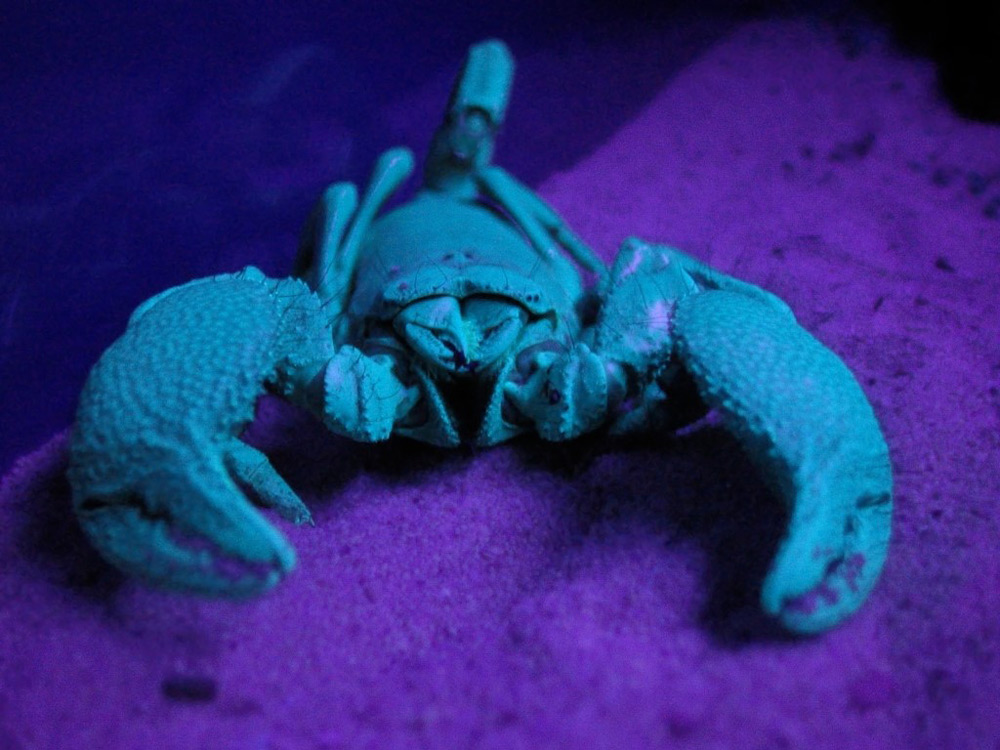Scorpions are predatory arachnids of the order Scorpiones. They have eight legs, and are easily recognized by a pair of grasping pincers and a narrow, segmented tail, often carried in a characteristic forward curve over the back and always ending with a stinger. The evolutionary history of scorpions goes back 435 million years. They mainly live in deserts but have adapted to a wide range of environmental conditions, and can be found on all continents except Antarctica. There are over 2,500 described species, with 22 extant (living) families recognized to date. Their taxonomy is being revised to account for 21st-century genomic studies.
Scorpions primarily prey on insects and other invertebrates, but some species hunt vertebrates. They use their pincers to restrain and kill prey, however scorpions themselves are preyed on by larger animals. The venomous sting can be used both for killing prey and for defense. During courtship, the male and female scorpion grasp each other's pincers and move around in a "dance" where the male tries to maneuver the female onto his deposited sperm packet. All known species give live birth and the female cares for the young as their exoskeletons harden, transporting them on her back. The exoskeleton contains fluorescent chemicals and glows under ultraviolet light. The vast majority of species do not represent a serious threat to humans, and healthy adults usually do not need medical treatment after being stung. Only about 25 species have venom capable of killing a human. However, human fatalities are frequent in some parts of the world with highly venomous species, primarily in areas with limited access to medical treatment. Scorpions, with their powerful stingers, appear in art, folklore, mythology, and commercial brands. Scorpion motifs are woven into kilim carpets for protection from their sting.

Fluorescence
Scorpions glow a vibrant blue-green when exposed to certain wavelengths ranges of ultraviolet light such as that produced by a black light, due to fluorescent chemicals such as beta-carboline in the cuticle. Accordingly, a hand-held ultraviolet lamp has long been a standard tool for nocturnal field surveys of these animals. Fluorescence occurs as a result of sclerotisation and increases in intensity with each successive instar. This fluorescence may have an active role in the scorpion's ability to detect light


Venom costs
Venomous organisms inject chemical cocktails into their predators and prey in order to disrupt normal biological functioning in their target. These chemical weapons are often rich in proteins, peptides, and small molecules. Whilst venom
Provides survival benefits by aiding in prey capture and predator defense, the benefits come with costs. These costs are two-fold, involving direct energetic costs associated with production and storage of toxins, and further indirect costs associated with a reduced capacity to capture prey or defend when supplies are depleted. Whilst these costs have different types of impacts on venomous animals, the methods to reduce these costs can overlap. It has been proposed that due to costs associated with venom use, organisms will meter/optimize the volume of venom they inject in order to use their venom as economically as possible in different situations. Research into optimal venom use has primarily focused on snakes, spiders, and scorpions. Scorpions utilize venom to both capture prey and defend against predators, which can include organisms with very different physiologies and susceptibility to venom components. Over 400 million years of evolution have led scorpions to develop a wide range of mechanisms that help minimize the costs of venom use. Successful prey capture and predator defense will ultimately affect a scorpion’s evolutionary fitness, and therefore selection on venom composition and concentration is generally influenced by both prey and/or predators. As selection pressures vary between environments, so will optimal investment in venom. Scorpions adapted to different ecological niches often show large differences in venom composition and stinger morphology, and this likely reflects responses to different selection pressures.








